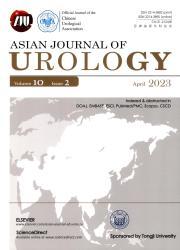腹腔外单部位机器人辅助根治性前列腺切除术后短期尿失禁的结果:一项回顾性研究
IF 2.4
3区 医学
Q2 UROLOGY & NEPHROLOGY
引用次数: 0
摘要
目的根治性前列腺切除术(RP)被认为是局部前列腺癌(PCa)患者的金标准治疗方法。所有接受RP的患者,无论是开放式、腹腔镜还是机器人,RP后都有发生尿失禁的风险。本研究旨在分析局部PCa腹腔外单位点机器人辅助RP (ss-RARP)术后早期(3个月内)尿失禁(UC)结果的可能预测因素。方法回顾性分析了2022年9月至2023年12月期间由经验丰富的外科医生进行手术的113例局限性PCa患者的资料。采用logistic回归分析患者特征(年龄、体重指数、前列腺体积、前列腺尺寸、术前和术后膜性尿道长度、膜性尿道切除百分比),以确定影响ss-RARP术后UC短期恢复的独立因素。从术后拔除尿管开始,每月随访UC的恢复情况,UC定义为每天使用≤1块安全垫,称为社交失禁。结果尿管拔除后立即、腹腔外ss-RARP术后1个月和3个月出现尿潴留的患者比例分别为22%、49%和82%。多因素logistic回归分析显示,尿路膜性尿道切除百分比(p=0.016)和前列腺体积(p=0.049)与拔除尿路后即刻社会UC恢复相关,前列腺颅径(p=0.042)和年龄(p=0.014)分别与腹腔外ss-RARP术后1个月和3个月社会UC恢复相关。结论膜性尿道切除率、前列腺体积、前列腺颅径、年龄是ss-RARP术后早期社会性UC的独立危险因素。本文章由计算机程序翻译,如有差异,请以英文原文为准。
Short-term urinary continence outcomes after extraperitoneal single-site robot-assisted radical prostatectomy: A retrospective study
Objective
Radical prostatectomy (RP) is considered the gold standard treatment for patients with localized prostate cancer (PCa). All patients undergoing RP, either open, laparoscopic, or robotic, are at risk of developing urinary incontinence after RP. Our study aimed to analyze possible predictors of early postoperative (within 3 months) urinary continence (UC) outcomes following extraperitoneal single-site robot-assisted RP (ss-RARP) for localized PCa.
Methods
We retrospectively reviewed data from 113 patients with localized PCa who were operated on by a highly experienced surgeon between September 2022 and December 2023. Patient characteristics (age, body mass index, prostate volume, prostate dimensions, preoperative and postoperative membranous urethral length, and percentage of membranous urethra removed) were analyzed using logistic regression to determine the independent factors contributing to short-term UC recovery after extraperitoneal ss-RARP. From the time of urinary catheter removal after surgery, the recovery of UC was followed up every month, and UC was defined as using ≤1 safety pad daily, known as social continence.
Results
The proportions of continent patients immediately after urinary catheter removal, 1 month, and 3 months after extraperitoneal ss-RARP were 22%, 49%, and 82%, respectively. The multivariate logistic regression analysis showed that the percentage of membranous urethra removed (p=0.016) and prostate volume (p=0.049) were associated with social UC recovery immediately after urinary catheter removal, and craniocaudal dimension of the prostate (p=0.042) and age (p=0.014) were associated with social UC recovery 1 month and 3 months after extraperitoneal ss-RARP, respectively.
Conclusion
The percentage of membranous urethra removed, prostate volume, craniocaudal dimension of the prostate, and age are independent risk factors for social UC early after extraperitoneal ss-RARP.
求助全文
通过发布文献求助,成功后即可免费获取论文全文。
去求助
来源期刊

Asian Journal of Urology
UROLOGY & NEPHROLOGY-
CiteScore
4.00
自引率
3.80%
发文量
100
审稿时长
4 weeks
期刊介绍:
Asian Journal of Urology (AJUR), launched in October 2014, is an international peer-reviewed Open Access journal jointly founded by Shanghai Association for Science and Technology (SAST) and Second Military Medical University (SMMU). AJUR aims to build a communication platform for international researchers to effectively share scholarly achievements. It focuses on all specialties of urology both scientifically and clinically, with article types widely covering editorials, opinions, perspectives, reviews and mini-reviews, original articles, cases reports, rapid communications, and letters, etc. Fields of particular interest to the journal including, but not limited to: • Surgical oncology • Endourology • Calculi • Female urology • Erectile dysfunction • Infertility • Pediatric urology • Renal transplantation • Reconstructive surgery • Radiology • Pathology • Neurourology.
 求助内容:
求助内容: 应助结果提醒方式:
应助结果提醒方式:


